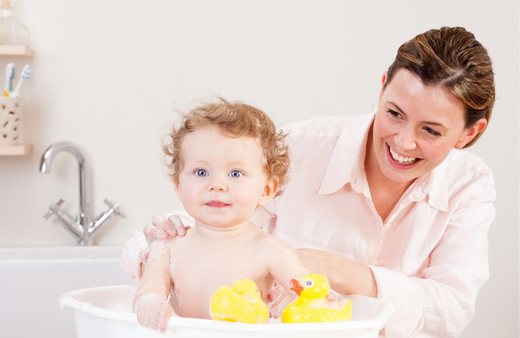Bathing a newborn baby can be a daunting task for new parents. It is an important part of baby care, but it requires special attention and care. In this article, we will provide a guide for new parents on how to bathe their newborn baby safely and effectively.
Newborns do not need daily baths. You should wait until the umbilical cord stump falls off and the circumcision, if any, is healed. Typically, this occurs within the first two weeks of life. Until then, you can clean your baby with a sponge bath.
-
Preparing for the Bath:

Before starting the bath, make sure you have all the necessary supplies, including a baby bathtub or sink, a mild baby soap, a soft washcloth, a cup for rinsing, and a clean towel. Also, make sure the room is warm and draft-free, and that you have everything you need within arm's reach.
-
Bathing Your Baby:

To bathe your baby, follow these steps:
a. Fill the tub or sink with 2-3 inches of warm water (around 100°F) and test the temperature with your elbow or wrist to ensure it is not too hot.
b. Undress your baby, leaving the diaper on for now, and gently lower them into the water, supporting their head and neck with one hand.
c. Use a soft washcloth and mild baby soap to gently wash your baby's body, starting with their face and working your way down. Pay special attention to the folds of their skin, such as under the arms, behind the ears, and in the diaper area.
d. Use a cup to rinse your baby, being careful not to get water in their eyes, nose, or mouth.
e. After the bath, carefully lift your baby out of the water and wrap them in a clean towel, patting them dry.
f. Finally, apply lotion or diaper cream as needed, dress your baby, and enjoy some cuddle time.
-
Bathing Tips:

a. Never leave your baby unattended in the bath, even for a second.
b. Use only mild baby soap and avoid getting it in your baby's eyes or mouth.
c. Support your baby's head and neck at all times.
d. Do not use hot water or cold water.
e. Be gentle when washing your baby, and do not scrub too hard.
f. Pat your baby dry, avoiding rubbing or friction on the skin.
Conclusion:
Bathing your newborn baby can be a bonding experience, but it requires special attention and care. By following the steps outlined in this guide, you can safely and effectively bathe your baby and provide them with the care they need. Remember to take your time, be gentle, and enjoy this special time with your little one.






